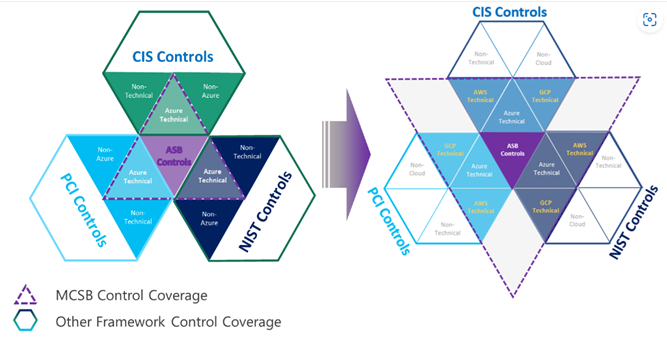Image Source: Microsoft Learn
Introduction
As organizations accelerate cloud adoption, securing cloud environments becomes paramount. Microsoft Cloud Security Benchmark (MCSB) provides a comprehensive set of best practices and security controls designed specifically for Microsoft Azure. It serves as a unified framework to strengthen your cloud security posture by mapping controls to industry standards and regulatory requirements.
MCSB isn’t just a checklist—it’s a strategic framework that helps security teams ensure their Azure deployments are secure by design, consistent, and compliant.
What is MCSB?
The Microsoft Cloud Security Benchmark is a curated set of security controls and recommendations across Azure services. It is tailored to provide actionable guidance to secure Azure workloads based on:
-
Industry best practices (e.g., NIST, CIS, ISO)
-
Microsoft’s security expertise
-
Real-world threat intelligence
MCSB maps each security control to multiple compliance frameworks, making it easier for organizations to meet both internal and regulatory requirements.
Core Control Domains in MCSB
MCSB is organized into control domains—think of them as functional areas of security. Each domain includes several specific controls. Here are the key domains:
1. Network Security
-
Secure network boundaries
-
Use of private endpoints and network segmentation
-
Enforce traffic filtering and monitoring
2. Identity and Access Management (IAM)
-
Enforce multi-factor authentication (MFA)
-
Use least privilege access
-
Integrate with Azure Active Directory (AAD)
3. Privileged Access
-
Just-In-Time (JIT) access
-
Azure AD Privileged Identity Management (PIM)
-
Role-based access control (RBAC)
4. Data Protection
-
Encryption at rest and in transit
-
Key management with Azure Key Vault
-
Data classification and labeling
5. Asset Management
6. Logging and Threat Detection
-
Enable Azure Monitor and Microsoft Defender for Cloud
-
Centralize logs using Log Analytics
-
Integrate with SIEM (e.g., Microsoft Sentinel)
7. Incident Response
8. Posture and Vulnerability Management
-
Use Defender for Cloud Secure Score
-
Regularly scan for vulnerabilities
-
Apply security baselines to resources
9. Endpoint Security
10. Backup and Recovery
Visit for more details on each security control: https://learn.microsoft.com/en-us/security/benchmark/azure/overview
MCSB vs. Other Security Frameworks
MCSB complements and enhances other security benchmarks by:
-
Mapping to industry standards like NIST SP 800-53, CIS Controls, ISO/IEC 27001
-
Providing Azure-specific guidance
-
Offering continuous updates based on Microsoft threat intelligence
It’s like having a cloud-native version of CIS or NIST, fine-tuned for Azure.
Implementation Strategy
To get the most out of MCSB:
-
Assess Current Posture
-
Prioritize Controls
-
Automate Where Possible
-
Continuously Monitor
The Microsoft Cloud Security Benchmark is more than a framework—it’s a foundational pillar for Azure security maturity. By aligning your cloud environment with MCSB controls, you strengthen your defense against threats while meeting industry and regulatory expectations.
Secure smarter, not harder. Let MCSB be your cloud security blueprint.


